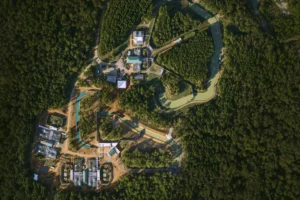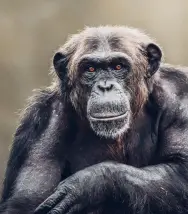

All gifts matched this July!
Help stock the sanctuary for the summer – all donations are doubled! (Up to $15,000)

Written by: Hailey Adams, Behavior Technician
Long shadows stretch from the trees as I move along the narrow trail following my dog, Parker, closely. We are walking the “monkey trails” named for their proximity to Chimp Haven, though they really should be called the “great ape” trails.
We’ve started our hike early in the morning to avoid the dreaded Louisiana heat. The air is already damp with humidity causing my shirt to cling to my skin. Parker turns in my direction ears perked forward, alert, and listening to something behind me. I hear what has caught my pup’s attention as the voices of more than three hundred chimpanzees rises over the tree tops. I guess that my co-workers are probably feeding the chimps, a task that is also mine when not on my day off.

The cacophony of chimp sounds reverberating throughout the trees makes me feel as if I have been transported to the jungles of Africa. As Parker and I continue our hike, my mind begins to think back to when I first started working at Chimp Haven. Immediately my thoughts travel to a chimp named Hawkins, one of the first chimps I bonded with at the sanctuary, whose journey at Chimp Haven I have had the pleasure of witnessing from his very first day.
Hawkins arrived at Chimp Haven in early 2018 with two other males. Hawkins is a slim, light-faced chimp who had two characteristics that were immediately apparent: One, he liked to play chase, and two, he was a talented thrower. His favorite projectile, unfortunately for staff, is poop. The majority of chimps who throw usually stick with one style – overhand or underhand or some other variation. Hawkins is unique in that he has about four or five different styles, including several creative ones that involved clapping. He became an expert at keeping staff on our toes, and there were many a time when we’d scatter at the sound of his clap, knowing that something unpleasant was headed our way.

Shortly after Hawkins’ small group of boys arrived, Chimp Haven received a group of five female chimpanzees. The most distinct of the group was Hope, who has alopecia and is completely bald. There was also Lori who had a dark face and was very sassy; Leanne with her distinct mutton-chop beard; and last but certainly not least two rather chunky and round girls, Heidi, who gained the nickname “the bowling ball,” and Robbie, the larger and more assertive of the two who became known as “the wrecking ball.”
All chimps at Chimp Haven are housed in social groups, mimicking the way they live in the wild. We commonly have chimps arrive at the sanctuary in groups of five or less. These groups are observed, assessed, and introduced to other groups of chimps who we believe have compatible personalities. Soon it was decided that Hawkins and his boys would meet the five girls.
There are chimps who, when they are introduced to new chimps, astound staff with their social prowess. Watching them move throughout their new group is something like watching a dance whose mood is ever changing. They show proper submission to dominant chimps, hold their own against some who may need a little more discipline, and are gentle towards those that are more timid.
Hawkins is not one of these chimps.
In fact, Hawkins’s behavior upon meeting the five females confused humans and chimps alike. He ran toward the females, stomping his feet as if he wanted to play, but his facial expression never changed, and the girls – confused at his intentions – initially ran from him. When they were finally brave enough to allow Hawkins to interact with them, he alternated between playing, hitting and stomping his feet.
From all appearances it seemed Hawkins was also confused about what he was doing. Fortunately for him, Hope is the ultimate social butterfly. She was very patient with Hawkins, panting at him in greeting when he approached and reaching her hand out towards him showing that was friendly. She even went so far as to embrace Hawkins.
Eventually he began to calm down and even engaged in some calm play with Hope and Robbie. The introduction was a success and the little group of eight was in for many more adventures together.
Their next adventure would be positive reinforcement training.
Positive Reinforcement Training is a key component of caring for the chimps at the sanctuary. It helps with shifting (moving the chimps from one area to another so we can clean their enclosures), allows us to more easily asses and treat medical issues, and provides the chimps with enrichment by allowing them to use their intelligence.
At Chimp Haven we use positive reinforcement training, a method of training that rewards the chimps when a behavior is done correctly. To become a trainer, staff must go through several written tests. They are then assigned a mentor who teaches them to work with chimps who already know common behaviors, and then they are assigned a “naïve” chimp, which is a chimp who has never been trained before.

My naïve chimp was Hawkins. I’ve heard many animal care professionals say that nothing will teach you patience like working with animals, and in my years in this profession I’ve found this to be one of the truest statements I’ve ever heard. I’ve worked with many animals who were excellent teachers of patience, to which I am very thankful.
Little did I know, Hawkins was about to put all those lessons to the test.
With a training bucket filled with treats, a cue stick, a target, and a clicker, my mentor and I began our first session with Hawkins. All training at Chimp Haven is voluntary, so chimps always get to choose whether or not they want to participate. Hawkins, upon seeing all the new items I had, was immediately curious and came right over.
When it comes to training, the clicker is key in communicating with the chimp. When a behavior is completed correctly, we need an immediate signal to let them chimp know – the click is the fastest way of letting them know they’ve succeeded and a treat is on the way.
Generally one of the first things a naïve chimp learns is what the click means. This is known as “click and treat.” Simply put, you click and then give the chimp a treat so they begin to associate the click with a positive behavior and a reward.
When I first tried this with Hawkins, I clicked, then reached into my bucket to give him a treat. As soon as my hand disappeared into the bucket he rather rudely threw a piece of kale in my face.
So, I tipped the bucket up to show Hawkins what was inside. He made a happy, quiet hooting noise showing his interest.
I clicked again, and this time when I reached into the bucket, he threw a handful of hay in my face.
Often when a chimp is struggling to learn a new behavior the solution can come in the form of another chimp. Robbie, upon seeing that I had treats, had immediately plopped her bulk down next Hawkins. Hand turned backwards and resting on her hip behind her protruding belly, she regarded me with her usual stoic expression.
I once again reached into my bucket, but this time focused on Robbie and gave her a piece of fruit, which she happily accepted. I clicked and treated with Robbie a few more times while Hawkins watched closely.
Once again I clicked while focusing on Hawkins…and this time, he allowed me to treat him!
Robbie was also key in teaching Hawkins his very first behavior, which was “target.” Out targets are typically made of PVC, and we ask chimps to touch the target with their finger. This behavior can be helpful in asking chimps to move from one spot to another, as well as asking a chimp to sit still.
When I first showed Hawkins the target, he showed the same uneasiness he had with the bucket – and again responded by throwing various objects at me. So again, I held the target up to Robbie, and without hesitation she stuck her finger through the mesh and touched it.
This time, however, Hawkins was not convinced, and I had to do target with Hope and Spock as well as Robbie several times before he felt comfortable enough to try it himself. While Hawkins had watched the other chimps in his group do target with their fingers, he decided to put his own flare on the behavior. When I held the target in front of him, slowly and carefully he stuck his tongue out and gingerly touched the target with it.
“Good!” both my mentor and I happily cried as I clicked and then gave Hawkins his treat, to which he responded by happily galloping around the room to celebrate.
As our training sessions continued Hawkins would gallop after every click, knowing that he had done the behavior correctly. Contrarily, if Hawkins did not hear a click (meaning he had done the behavior incorrectly) he would respond with a deflated sighing noise.
As time went on it became clear that the little group of eight were accepting of chimps of all different kinds and oddities. They become the perfect home for many of our “oddballs” and today are a group of sixteen.
Spock has become the group’s alpha and Hawkins is also a high-ranking chimp, though there is some question as to whether or not he knows it. In January of 2020 Hawkins and his group reached yet another milestone when they experienced one of Chimp Haven’s forested habitats for the first time.
Today, Hawkins and his group continue to thrive at Chimp Haven. He and Hope have become friends and the two are regularly seen sleeping together in their yard.
Hawkins’s training has also come a long way and he now knows how to present almost all of his body parts. As Hawkins continues to grow and have more new experiences at Chimp Haven, I believe he will meet each one as he has in the past, with a smidge of suspicion, a little curiosity, and a whole lot of his very own brand of quirkiness.
One thing I do know for sure is that he, like every other chimp I’ve ever met, will always be full of endless surprises.










